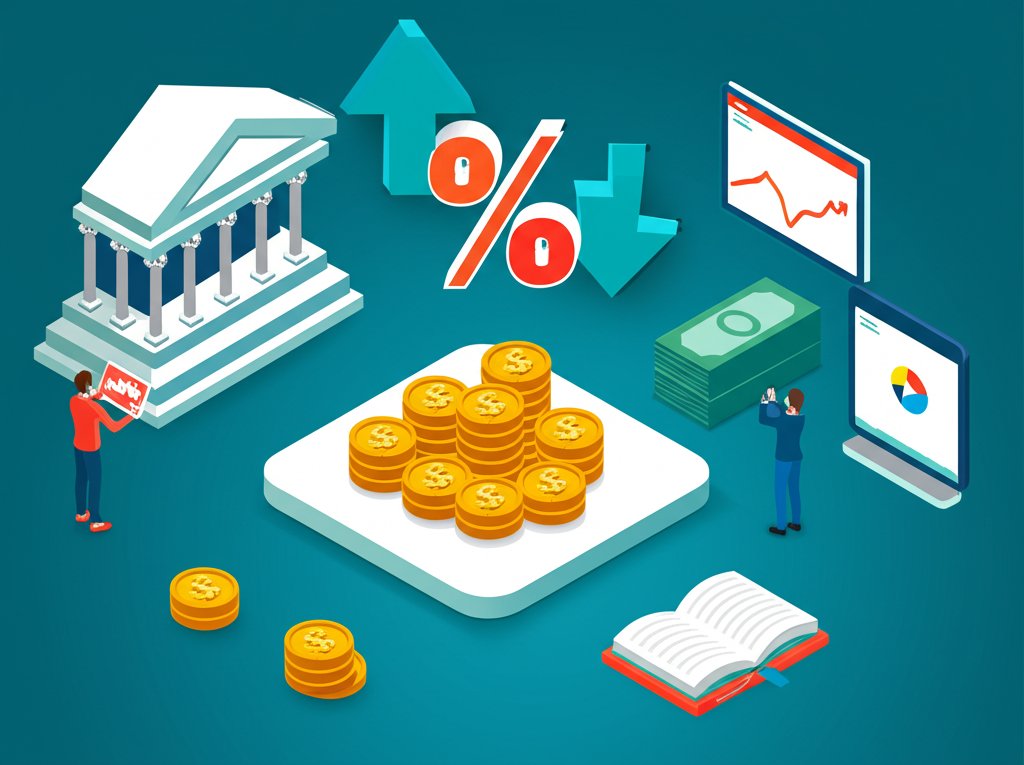In the dynamic world of finance, understanding subtle shifts can be the difference between merely observing market movements and actively mastering them. Among the most potent and often misunderstood signals is the “bear steepener.” This phenomenon, characterized by a rapid and significant rise in long-term interest rates relative to short-term rates, isn’t just a technical quirk; it’s a critical indicator with profound investment impact, dictating the flow of capital, influencing corporate decisions, and reshaping portfolio returns.
For investors, decoding the bear steepener is paramount to navigating an increasingly complex economic landscape. It signals a shift in market sentiment regarding future inflation, economic growth, and monetary policy, directly affecting yields across the board. This comprehensive guide will equip you with the knowledge to understand what a bear steepener is, what causes it, its far-reaching investment impact, and how to strategically adapt your portfolio for success in these challenging yet opportunity-rich conditions. Prepare to master the signals and optimize your long-term interest rates strategy.
Decoding the Bear Steepener: A Fundamental Shift in Yield Dynamics
At the heart of financial markets lies the yield curve, a graphic representation of the relationship between the interest rates of bonds with different maturities. Normally, long-term interest rates are higher than short-term rates, reflecting the added risk and uncertainty of lending money for longer periods. A “bear steepener” is a specific and dramatic alteration of this curve.
What Exactly is a Bear Steepener?
A bear steepener occurs when the yield curve steepens, meaning the spread between long-term interest rates and short-term rates widens, but with a crucial distinction: it’s driven by a rise in both short and long rates, with long rates rising faster and more substantially. Imagine a flexible ruler anchored at one end (short-term rates). When a bear steepener happens, the far end (long-term rates) shoots upwards, pulling the middle section with it but leaving the anchored end relatively stable or rising at a much slower pace.
This movement contrasts with a normal steepening, which can occur during periods of economic recovery where the market simply anticipates higher growth and thus normalizes the term premium. The “bear” in bear steepener signifies a potentially negative economic outlook or apprehension, even if some elements might appear positive on the surface. It’s a powerful signal about future yields and expected investment impact.
The Mechanics of the Market Seesaw
To visualize this, consider the yield curve as a seesaw. Short-term interest rates are on one side, influenced heavily by central bank policy and immediate liquidity needs. Long-term interest rates are on the other, reflecting future economic expectations, inflation outlook, and the demand for long-term capital.
In a bear steepener scenario:
The resulting steeper curve implies that investors demand substantially higher compensation for the risks associated with holding debt over extended periods, particularly the risk that inflation will erode the real value of their principal and yields.
The Catalysts: Why Long-Term Interest Rates Surge

Understanding the “why” behind a bear steepener is crucial for anticipating its investment impact. Several interwoven factors can conspire to push long-term interest rates upwards more aggressively than their short-term counterparts.
Inflationary Pressures and Expectations
The most common and potent driver of a bear steepener is a significant increase in inflation expectations. When investors anticipate that prices for goods and services will rise sharply in the future, they demand higher yields on long-term interest rates to compensate for the erosion of their purchasing power. Lenders will not commit capital for many years if they believe the money they get back will be worth substantially less. This “inflation premium” gets baked into bond yields, especially for longer maturities.
This can be triggered by:
Central Bank Policy and Market Anticipation
Central banks, such as the U.S. Federal Reserve, primarily control short-term interest rates through policy tools like the federal funds rate. However, their actions and guidance can heavily influence long-term interest rates as well.
Robust Economic Growth or Persistent Uncertainty?
The interpretation of economic conditions during a bear steepener can be nuanced.
For a deeper understanding of how these macroeconomic factors affect your personal finances and investment strategies, resources like the ones provided at MyFinanceLab can offer tailored guidance.
The Profound Investment Impact Across Asset Classes
The emergence of a bear steepener sends ripples through the entire financial market, fundamentally altering the calculus for various asset classes. Understanding these implications is key to mitigating risks and identifying opportunities.
Fixed Income: Bonds Under Pressure
For bond investors, a bear steepener is generally a challenging environment.
Equities: Sectoral Winners and Losers
The investment impact on the stock market is mixed and often leads to sector rotation.
Real Estate and Lending: Higher Borrowing Costs
The real estate market is highly susceptible to changes in long-term interest rates.
Currencies and Global Flows
A bear steepener in a major economy (like the U.S.) can attract international capital.
Mastering the Bear Steepener: Actionable Investment Strategies
Given the significant investment impact of a bear steepener, proactive strategies are essential for preserving capital and finding growth opportunities.
For Bond Investors: Duration Management and Yield Harvesting
- Shorten Duration: Reduce exposure to long-term bonds. Shift towards shorter-term bonds, bond ladders, or ultra-short bond ETFs. This minimizes the impact of rising long-term interest rates on your portfolio’s value.
- Floating-Rate Securities: Consider floating-rate notes or funds that adjust their coupon payments as interest rates change. This provides some protection against rising rates.
- Inflation-Protected Securities (TIPS): If inflation is the primary driver, TIPS can offer a hedge, as their principal value adjusts with inflation.
- Yield Harvesting: While long-term bond prices fall, their yields increase. For investors with new capital to deploy, this presents an opportunity to lock in higher long-term interest rates for future income, provided they are comfortable with potential short-to-medium term capital depreciation.
For Equity Investors: Sector Rotation and Defensive Plays
- Favor Value Over Growth: Shift allocations from high-growth sectors to value-oriented sectors that are less sensitive to interest rates or benefit from them.
- Overweight Financials: As discussed, banks and insurance companies often thrive in a steepening interest rates environment due to improved net interest margins.
- Consider Cyclical Stocks: If the steepening is partly driven by genuine economic strength, some cyclical sectors (e.g., industrials, materials) could perform well.
- Defensive Stocks with Pricing Power: Companies in essential services (e.g., consumer staples, healthcare) that can pass on higher costs to consumers are often more resilient during inflationary periods.
Hedging with Derivatives: Advanced Tactics
For experienced investors with a deep understanding of market mechanics, derivatives can be used to hedge against or profit from a bear steepener.
Portfolio Diversification and Risk Management
No single strategy is foolproof. A well-diversified portfolio remains your best defense.
Bear Steepener in Context: Distinguishing Yield Curve Movements
Understanding the bear steepener requires distinguishing it from other significant movements of the yield curve, each with its own set of causes and investment impact.
Bear Steepener vs. Bull Steepener
While both involve a steepening of the yield curve, their underlying drivers and implications are vastly different.
Bear Steepener vs. Flatteners (Bear Flattener, Bull Flattener)
The opposite of steepening is flattening, where the spread between short and long-term interest rates narrows.
Each of these yield curve movements provides unique insights into market sentiment regarding interest rates, inflation, and economic growth, profoundly affecting investment impact.
Historical Precedents and Forward-Looking Signals

History offers valuable lessons about the bear steepener and its investment impact. While no two economic cycles are identical, observing past patterns can provide context for current market conditions.
Lessons from Past Episodes
Several periods have seen prominent bear steepeners:
These historical examples underscore that a bear steepener is often associated with significant shifts in monetary policy, inflation dynamics, and government fiscal stances. The investment impact during these times has been highly varied across assets.
What to Watch For: Key Economic Indicators
To anticipate or react to a bear steepener, investors should monitor:
By maintaining vigilance over these indicators, investors can better position themselves to understand and navigate the powerful forces behind long-term interest rates and their investment impact.
Conclusion
The bear steepener is a compelling and often challenging signal within the financial markets, indicative of a period where long-term interest rates are rising faster than their short-term counterparts. Driven by factors like surging inflation expectations, aggressive central bank policy, or robust demand for capital, its investment impact is far-reaching, affecting everything from bond prices and equity sectors to real estate and currency valuations.
Mastering yields for investment success in such an environment requires a deep understanding of these dynamics. It means acknowledging the potential headwinds for certain assets, particularly long-term fixed income, while identifying opportunities in sectors like financials or short-duration strategies. By recognizing the causes, understanding the nuances compared to other yield curve movements, and employing a range of adaptive strategies, investors can transform a period of uncertainty into a pathway for informed decision-making. Stay vigilant, remain adaptable, and empower your portfolio with the insights needed to thrive in any market condition.
FAQ Section
What is the primary difference between a bear steepener and a bull steepener?
The primary difference lies in what drives the steepening of the yield curve. A bear steepener occurs when long-term interest rates rise significantly faster than short-term rates, often due to high inflation expectations or increased supply of long-term debt. It typically signals investor anxiety or an overheating economy. Conversely, a bull steepener happens when short-term interest rates fall faster than long-term interest rates, usually driven by central bank cuts to stimulate a slowing economy. It’s often seen as a precursor to economic recovery.
How does a bear steepener affect bond prices and yields?
During a bear steepener, bond prices generally fall, especially for long-term bonds. This is because market interest rates (and thus yields) are rising. When new bonds are issued at higher yields, older bonds with lower fixed coupons become less attractive, causing their market value to decline. The longer a bond’s maturity (its duration), the more sensitive its price is to these rising long-term interest rates, leading to greater capital losses for long-term bondholders. For new money, however, the rising yields present an opportunity to lock in higher rates for future income.
Can a bear steepener indicate an impending recession?
Not directly. While some yield curve movements (like an inverted yield curve) are strong recession predictors, a bear steepener itself is less clear-cut. It often signals strong inflation concerns or an economy that is growing robustly but perhaps unsustainably. However, if the central bank begins to aggressively raise short-term interest rates to combat the inflation implied by the bear steepener, these actions could lead to a recession down the line. So, it’s more of a signal of potential economic stress or policy response rather than an immediate recession warning.
What types of investments typically perform well during a bear steepener?
During a bear steepener, investments that typically perform well include:
Is it always a negative sign for the economy?
Not necessarily, but it is often associated with economic challenges or the perception of them. A bear steepener can reflect investor concerns about persistent inflation eroding the value of their investments over time, or worries about excessive government debt. While it might indicate a robust economy demanding more capital, the “bear” aspect implies an underlying apprehension, often about higher future borrowing costs or the central bank’s tightening cycle. Its interpretation requires careful consideration of the specific economic context and the dominant factors driving long-term interest rates higher.










